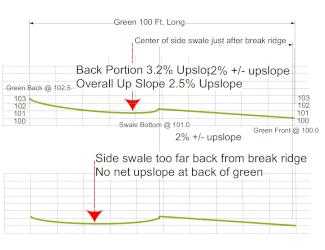Featured Golf News
Why Do Greens Slope Back to Front?
A green that slopes downhill from back to front provides two advantages:

1. It is more visible to golfers, and
2. It helps stop momentum of the approach shot, helping it hold the green.
There is a small "retro" trend toward designing some greens that slope to the back or sides. Many old courses had greens with these features. After WWII, or possibly before, back-to-front became standard, as the aerial game became standard.
Greens sloping to the back or sides make approach shots play differently than the standard back to front, introducing challenge and variety. However, the majority of even good players don't seem to care for those kind of greens, preferring predictability over shot-making creativity.
Most average players truly depend on the green to help them keep scores reasonable. For them, a "good shot" is one that gets airborne and flies in the right general direction. If it happens to hit the green, they expect the green contours to assist them to hold the green, and get frustrated when their good shots are kicked over or off the side of the green.
Also, good players recognize how green contours affect an approach shot, while most average players are less savvy, and may continually misplay an approach shot calling for a different strategy for years.
From field research, I have found that any part of the green we wish to hold "standard" shots with average backspin must slope upwards at least 1.3%, at least on average 9-10 green speeds. I also theorize, but find it impossible to measure precisely, these good rules of thumb:

• Faster greens require more slope to hold shots, while also require less slope for "fair putting." If greens get much faster, that will be a real dilemma.
• The general upslope of the green should be steeper for longer approach shots, or about 1% of shot distance, i.e., 1.3% for 130 yards, 1.6% for 160 yards, and 1.9% for 190 yards, etc., to compensate for lower angle and spin rates on longer shots.
• Shots predictably into the wind require less slope to help stop shots, as headwind increases spin. In fact, sometimes too much slope causes too much backspin for good players.
• Shots predictably with the wind require more upslope to help stop shots, as tail wind reduces spin.
• Shallow greens may require more upslope and deep greens may require less, both as assistance in stopping shots and visibility. (The back green edge must be 1.5-2 feet higher than the front for visibility, whether a steeper slope on a shallower green, or a softer slope on a deeper green.)
Hence, back to front is the standard for the majority of greens I design, and it seems to be the case with most architects. I believe a course can have a few cases of side and reverse slope greens for variety, providing great care is taken to allow a fair way to play the shot, given how the ball will react for players.
Jeffrey D. Brauer began his career as an apprentice in the Chicago area in 1977. His first project was Kemper Lakes, which shortly after hosted the 1989 PGA Championship. He formed GolfScapes in Arlington, Texas, in 1984. In the last 29 years he has designed and consulted on a wide spectrum of projects, ranging from partial renovations to international resorts. His recent work includes teaming with the design team of Pascuzzo and Pate on a remodel of the world-famous La Costa Resort & Spa in California, and renovations at Superior National Golf Course in Lutsen, Minn., and Mesquite Municipal Golf Course in Mesquite, Texas.
He has been a member of the American Society of Golf Course Architects since 1981, serving as President during its 50th Anniversary year in 1995-96. Jeff still studies the classic works - both old and new, and has played more than 75 of the best courses in the world.
Jeff gives many presentations and is a regular architecture columnist for many publications and websites, including Golf Course Industry and Cybergolf.com. He has also been a strong advocate for the "Tee it Forward" campaign and strives to make his courses fit the description of "fun to play every day."
Jeff's work has been spotlighted in most of the world's major golf magazines. Golf World ranked him as one of the top-20 golf course architects and Golf Inc. ranked him as the world's fourth-best value in golf architecture in 2010. Jeff's portfolio and reputation keep him at the forefront of desired designers for new courses, reconstruction and renovation projects. For more about Jeff, visit http://www.jeffreydbrauer.com/sites/courses/layout.asp?id=859&page=48451.
Story Options
 |
Print this Story |
